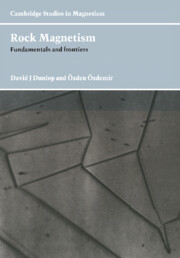Book contents
- Frontmatter
- Contents
- Preface
- Chapter 1 Magnetism in nature
- Chapter 2 Fundamentals of magnetism
- Chapter 3 Terrestrial magnetic minerals
- Chapter 4 Magnetostatic fields and energies
- Chapter 5 Elementary domain structures and hysteresis
- Chapter 6 Domain observations
- Chapter 7 Micromagnetic calculations
- Chapter 8 Single-domain thermoremanent magnetization
- Chapter 9 Multidomain thermoremanent magnetization
- Chapter 10 Viscous and thermoviscous magnetization
- Chapter 11 Isothermal magnetization and demagnetization
- Chapter 12 Pseudo-single-domain remanence
- Chapter 13 Crystallization remanent magnetization
- Chapter 14 Magnetism of igneous rocks and baked materials
- Chapter 15 Magnetism of sediments and sedimentary rocks
- Chapter 16 Magnetism of metamorphic rocks
- Chapter 17 Magnetism of extraterrestrial rocks
- References
- Index
Chapter 5 - Elementary domain structures and hysteresis
Published online by Cambridge University Press: 06 July 2010
- Frontmatter
- Contents
- Preface
- Chapter 1 Magnetism in nature
- Chapter 2 Fundamentals of magnetism
- Chapter 3 Terrestrial magnetic minerals
- Chapter 4 Magnetostatic fields and energies
- Chapter 5 Elementary domain structures and hysteresis
- Chapter 6 Domain observations
- Chapter 7 Micromagnetic calculations
- Chapter 8 Single-domain thermoremanent magnetization
- Chapter 9 Multidomain thermoremanent magnetization
- Chapter 10 Viscous and thermoviscous magnetization
- Chapter 11 Isothermal magnetization and demagnetization
- Chapter 12 Pseudo-single-domain remanence
- Chapter 13 Crystallization remanent magnetization
- Chapter 14 Magnetism of igneous rocks and baked materials
- Chapter 15 Magnetism of sediments and sedimentary rocks
- Chapter 16 Magnetism of metamorphic rocks
- Chapter 17 Magnetism of extraterrestrial rocks
- References
- Index
Summary
Introduction
Landau and Lifschitz (1935) predicted the existence of ferromagnetic domains as a means of reducing magnetostatic energy. As they put it, ‘Elementary regions of nearly saturation magnetization in a ferromagnetic crystal result from the demagnetizing effect of the surface of the body’. Their predicted domain configurations (Fig. 5.1a) agree quite closely with the patterns observed on a polished {110} surface of magnetite (e.g., Figs. 1.2, 5.8b). Landau and Lifschitz proposed a layered structure: lamellar body domains, with alternating directions of magnetization Ms1, Ms2, in the interior of the crystal; wedge-shaped surface closure domains, with Msc parallel or nearly parallel to the surface, providing flux closure paths between adjacent domains; and narrow domain walls in which Ms rotates through 90° or 180° between neighbouring domains. In magnetite, Ms rotates through 70.5° or 109.5° (the angles between adjacent 〈111〉 easy directions) rather than 90° across walls between closure and body domains (Fig. 5.1b).
The Landau–Lifschitz (LL) structure is remarkably effective in reducing demagnetizing energy. Ms is uniform within body and closure domains, and so there are no volume poles. Ms is parallel to 180° walls, and so for these walls. The 90° (or 70.5° and 109.5°) walls bisect the angle between Ms vectors in neighbouring body and closure domains. Thus σm due to the body domain exactly cancels σm due to the closure domain, and no surface poles appear on any interior boundaries.
- Type
- Chapter
- Information
- Rock MagnetismFundamentals and Frontiers, pp. 103 - 143Publisher: Cambridge University PressPrint publication year: 1997



